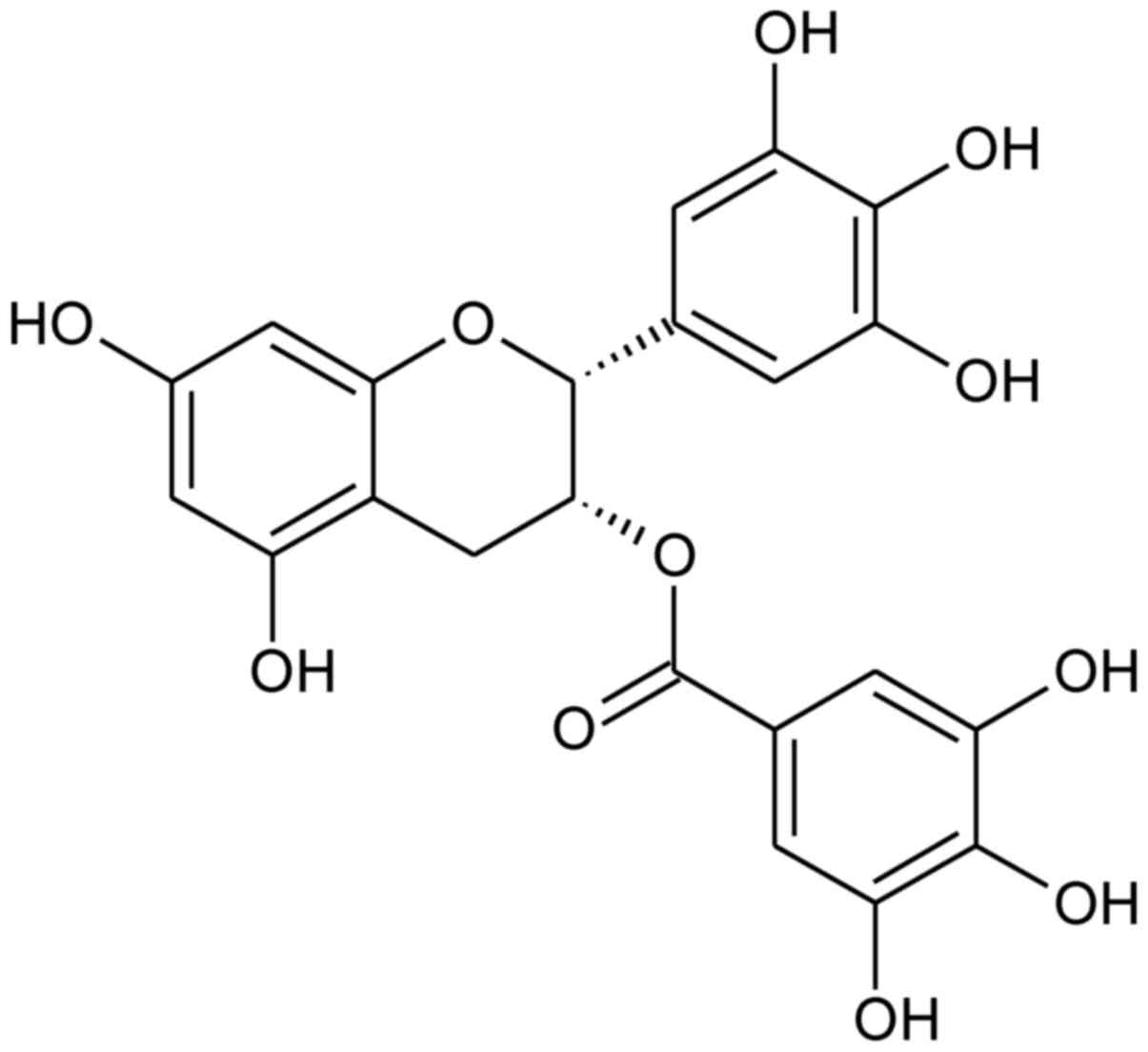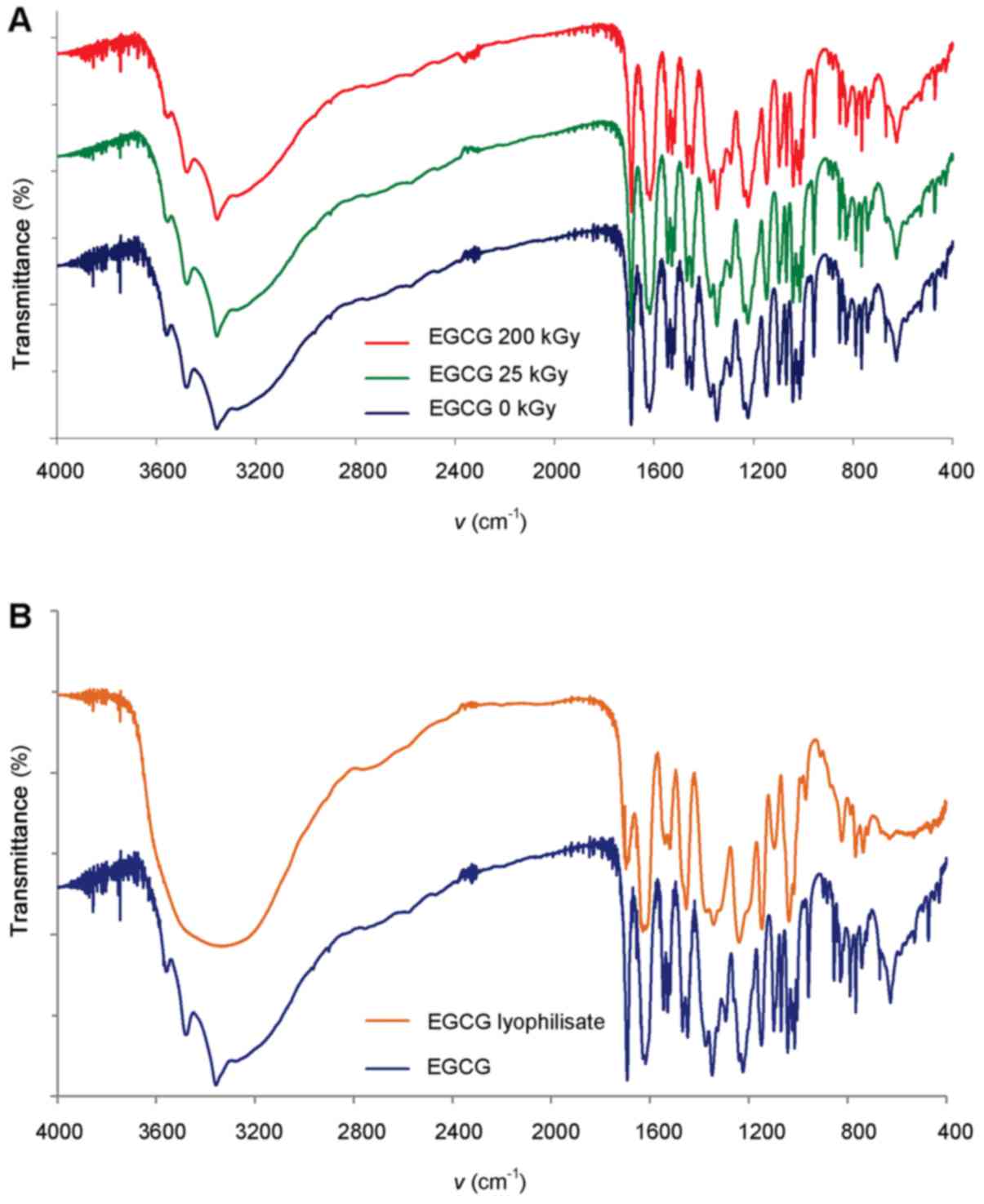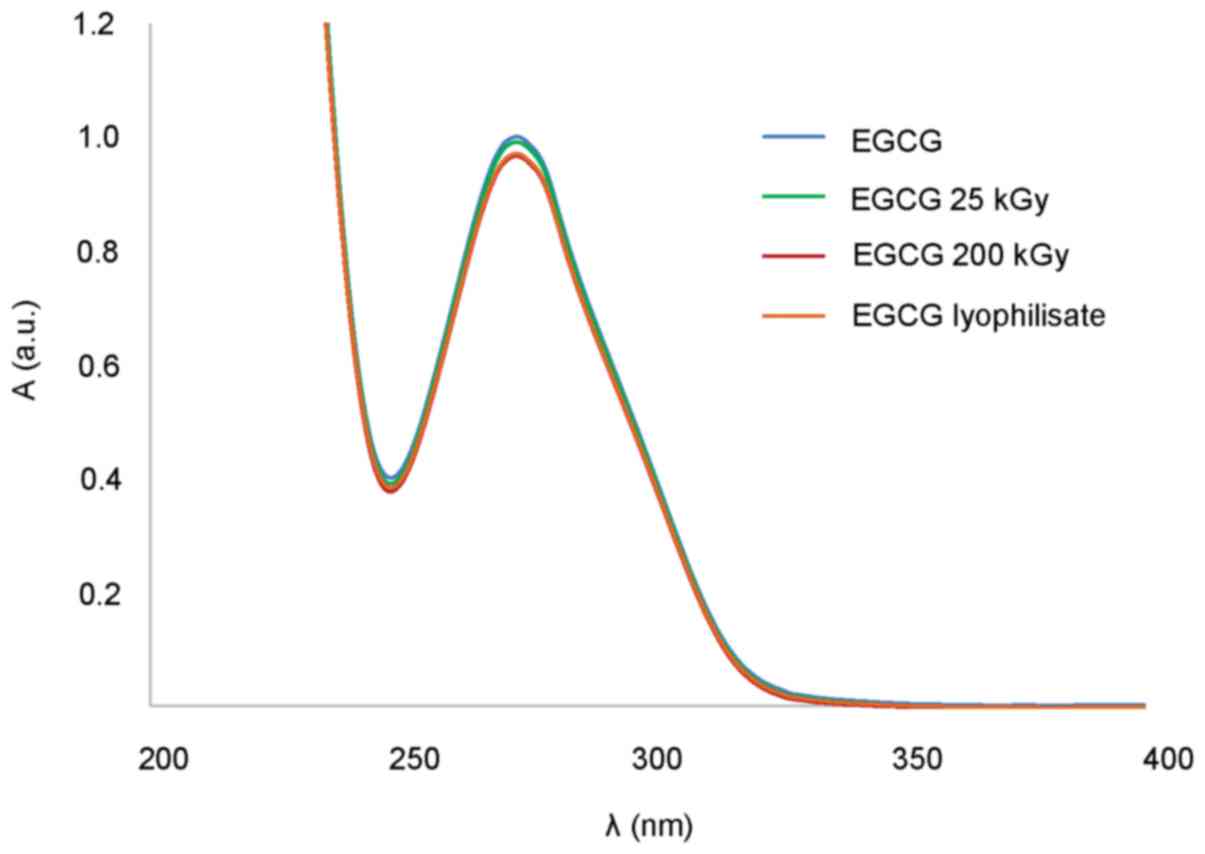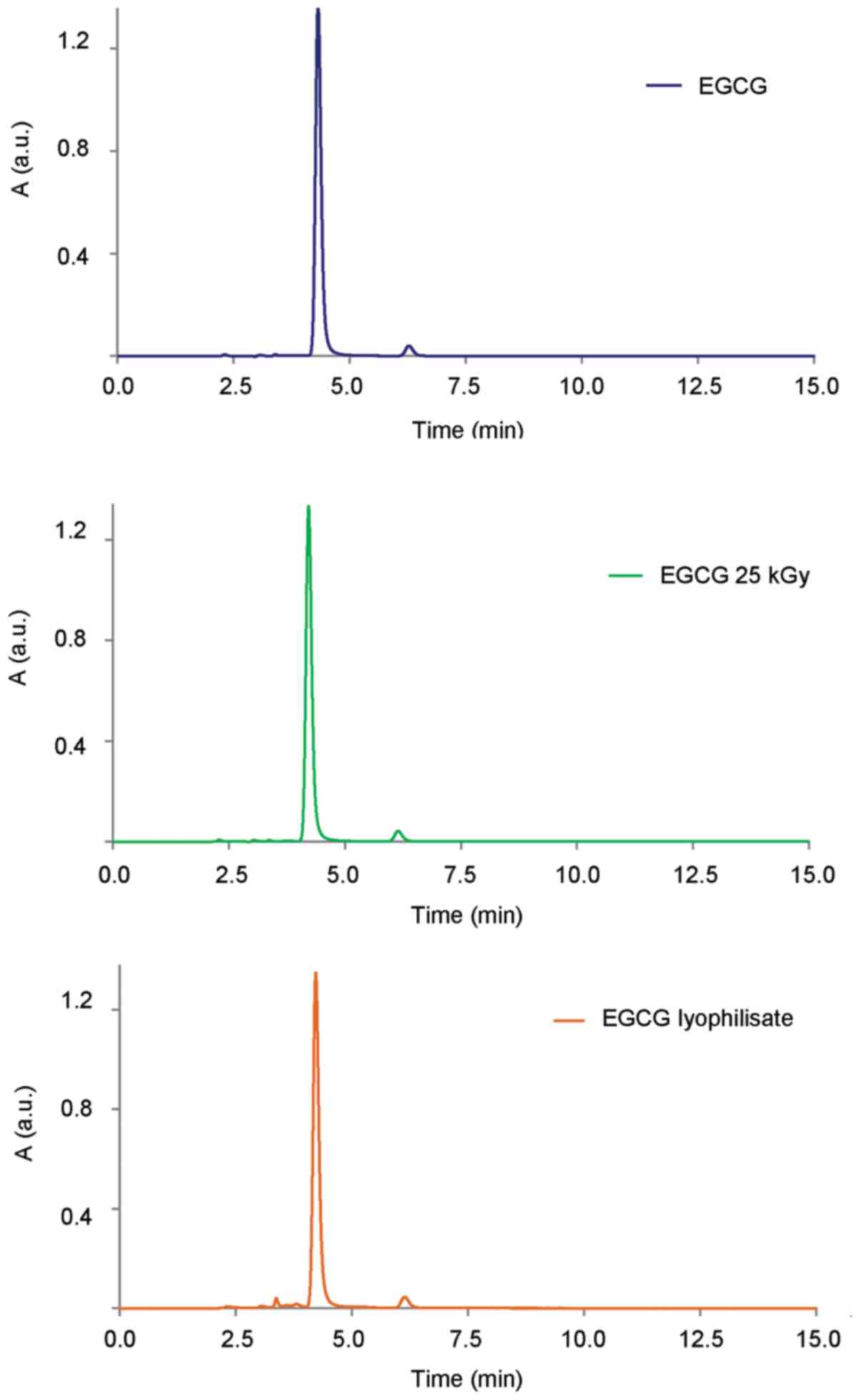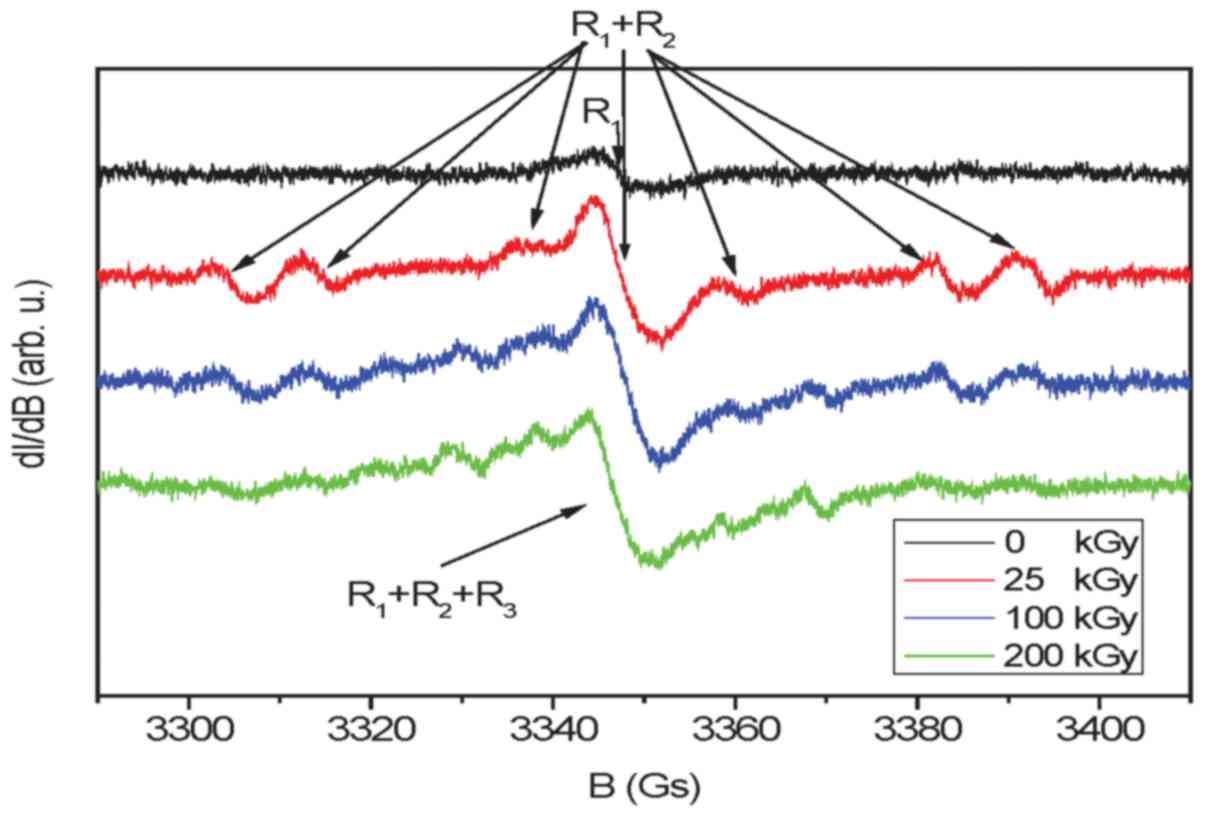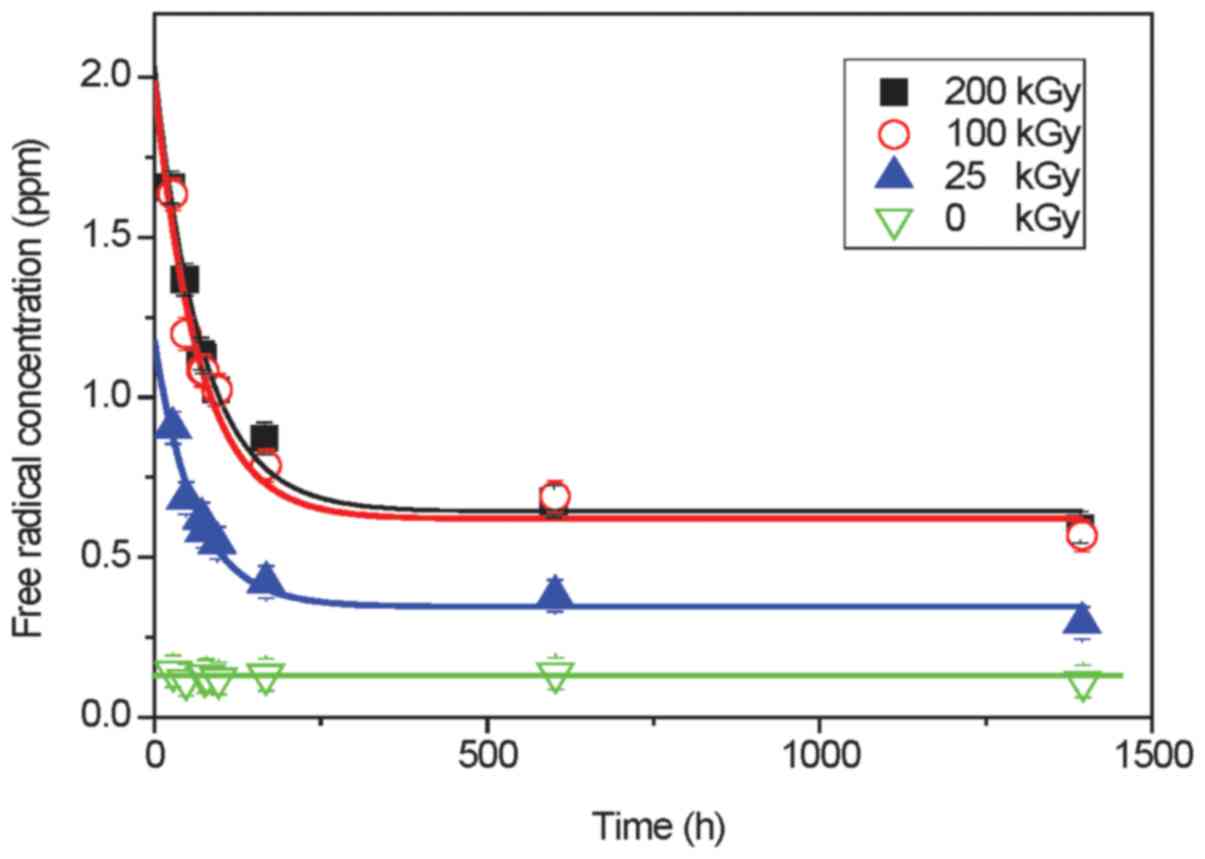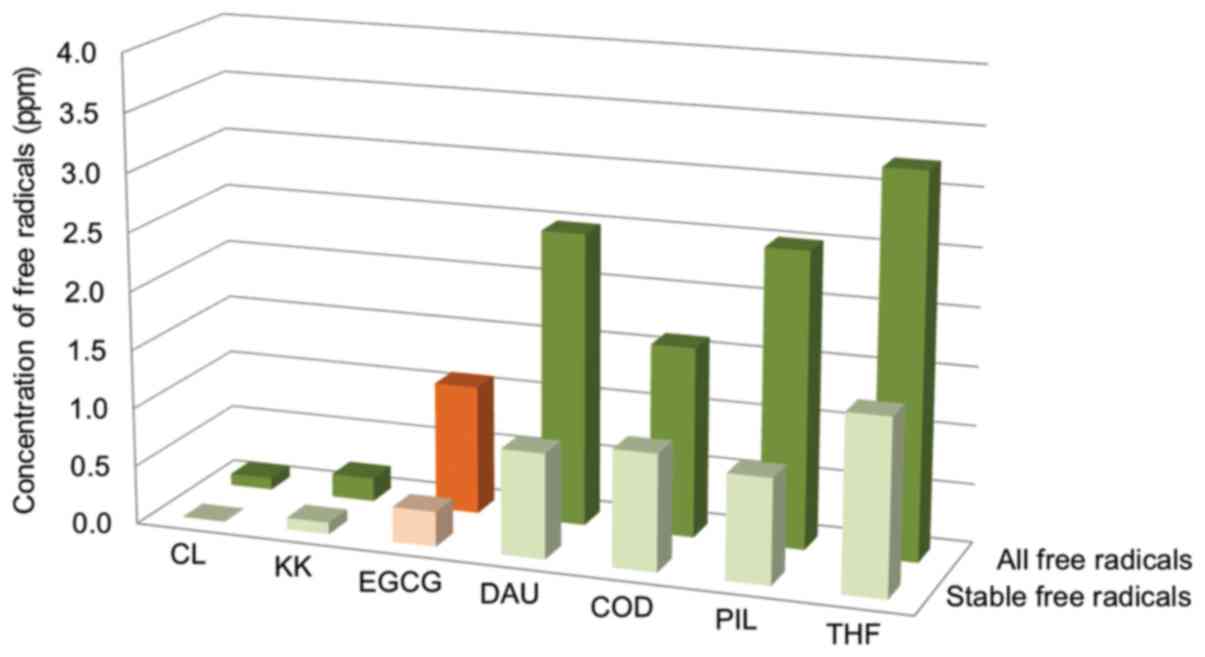Formulation and characterization of EGCG for the treatment of superficial bladder cancer
- Authors:
- Published online on: June 14, 2017 https://doi.org/10.3892/ijmm.2017.3024
- Pages: 329-336
-
Copyright: © Dettlaff et al. This is an open access article distributed under the terms of Creative Commons Attribution License.
Abstract
Introduction
In the United States, the incidence of urothelial cell carcinoma (UCC) of the bladder or transitional cell carcinoma (TCC) is approximately 70,000 new cases annually, leading to approximately 15,000 deaths. The risk factors for TCC are many, but most commonly include smoking, chronic cystitis and chemical exposure, including exposure to aniline dye. Initial presentation most commonly appears in the form of gross hematuria, but can also present with irritative voiding symptoms, anemia andrenal failure due to obstruction. The most common subtype of bladder cancer is superficial bladder cancer, namely the non-muscle invasive form limited to the urothelium. Of all new cases of bladder cancer, the non-muscle invasive type accounts for nearly 70%. The rate of progression and recurrence is up to 40 and 70%, respectively (1,2).
The gold standard initial treatment for bladder cancer includes cystoscopy and transurethral resection of the bladder tumor. During this time, malignant cells can float onto the adjacent epithelium, increasing the risk of recurrence. Once pathological evaluation confirms a non-muscle invasive disease, the standard of care to prevent recurrence and progression is the intravesical instillation of immunotherapeutic agents. Intravesical immunotherapy results in a massive local immune response characterized by the induced expression of cytokines in the urine and bladder wall and by an influx of granulocytes, and mononuclear and dendritic cells (3,4). Current intravesical treatments are costly and require the special handling of these agents. Patients are treated with intravesical therapy with bacillus Calmette-Guerin (BCG) bacterium, or mitomycin C (MMC) following resection. Both of these can cause severe side-effects, which are rarely life-threatening (3).
BCG, is an attenuated live vaccine for tuberculosis that has shown antitumor activity. The proposed mechanism of action is T-cell activation to attack abnormal urothelial cells and this may have a direct inhibitory effect on tumor cell invasion. Intravesical BCG has been shown to decrease tumor recurrence and progression. Intravesical treatment usually begins 2–4 weeks following transurethral resection to minimize systemic absorption and undesirable side-effects. Treatment regimens include an induction phase that consists of weekly instillation for 6 weeks as long as the patient can tolerate the agent. This is followed by a maintenance regimen that can last for 1–3 years, depending on the tumor grade and characteristics. Side-effects of the agent include cystitis, dysuria, malaise, fatigue and systemic inflammatory response syndrome, and can be as severe as BCG sepsis. Contraindications include immunosuppression, traumatic catheterization, active urinary tract infection or gross hematuria and a personal history of BCG sepsis (3,5–8). MMC is an alkylating agent that inhibits DNA synthesis. Intravesical MMC has a clear impact on tumor recurrence when immediately instilled following the transurethral resection of bladder tumor and in the adjuvant setting. There is no clear evidence of an impact on progression. MMC is usually administered immediately following the resection of the bladder tumor, as long as bladder perforation has not occurred. Systemic absorption, which can cause myelosuppression, is rare as MMC has a high molecular weight. Common side-effects include contact dermatitis and irritative voiding symptoms (3,5–8).
A meta-analysis of 9 clinical trials compared its efficacy on progression with that of BCG. Within a median follow-up of 26 months, 7.67% of the patients in the BCG group and 9.44% of the patients in the MMC group developed tumor progression (9). Another review found a 38% reduction in tumor recurrence with MMC. This was not as effective as BCG, but was considered in most studies to make MMC a viable option in light of its lesser side-effects, particularly the low, but real risk of sepsis (10).
We previously examined the efficacy of epigallocatechin-3-gallate (EGCG) in comparison with MMC in the prevention of tumor cell implantation/growth in an animal model of superficial bladder cancer (11). EGCG {[(2R,3R)-5,7-dihydroxy-2-(3,4,5-trihydroxyphenyl)chroman-3-yl] 3,4,5-trihydroxybenzoate; Fig. 1} is the most abundant catechin in green tea. EGCG and green tea extracts are under investigation for their potential effects on human health and disease (12–15). One of the promising uses of EGCG and green tea extracts is the prevention and treatment of cancer (16–19). Experiments on cells in vitro and on animal models in vivo have shown the anti-neoplastic activity of EGCG(17,20–24). However, the mechanism of action of EGCG is poorly understood due to the deficiency of analytical tools that can detect the precise behavior of such a small molecule. Nevertheless, numerous possible targets have been suggested, such as Janus kinase (JAK)/signal transducer and activator of transcription (STAT), mitogen-activated protein kinase (MAPK), phosphoinositide 3-kinase (PI3K)/AKT (25), urokinase-type plasminogen activator (uPA) and matrix metalloproteinases (MMPs) (26–29). The mechanisms of action of EGCG make matters more complicated, given the fact that it is labile in aqueous solutions. It has been reported that auto-oxidation and epimerization are the two major reactions responsible for the instability of EGCG (30). Green tea catechins, including EGCG bind to plasma proteins that alter their plasma concentration, tissue delivery and biological activity. Incubation with human serum albumin (HSA) green tea extracts and pure EGCG results in full binding to HSA (31,32). Moreover, poor absorption results in the low systemic bioavailability of EGCG following oral administration and its conversion to the glucuronide renders EGCG even less available in the circulation (33,34). EGCG is highly unstable under sunlight (35). This polyphenol, following exposure to irradiance, such as natural sunlight, photo-degrades approximately 69%, after 1 h of irradiation. The inclusion of UVB (290–320 nm) produces a photo-degradation EGCG of 61% (36). However, at least to the best of our knowledge, there are no studies available to date on the effects of ionizing radiation on the stability of this polyphenol. Therefore, it seems that it is safer to use green tea extracts or EGCG in situ for the treatment of different ailments. There are several clinical studies on humans using topical EGCG treatment (37–39). EGCG treatment has also been approved by the United States Food and Drug Administration (polyphenon E - purified extract of green tea) ointment for external genital warts treatment (40,41).
We previously studied the efficacy of EGCG in comparison with MMC to prevent tumor cell implantation/growth in an animal model of superficial bladder cancer and investigated the possible mechanisms of action. Female Fisher 344 rats were used to study the in situ effects of EGCG and MMC for the prevention of transitional rat cell tumor implantation (AY-27) (11). Experiments revile the slightly better effects of EGCG than MMC in these experimental animals. Thus, EGCG can be used as an agent to decrease tumor cell implantation and consequent intravesical cancer growth in a bladder. The use of EGCG is a potential novel therapeutic strategy for use as an adjunct to endoscopic bladder tumor resection. These data suggest that EGCG lowers proteolytic activity and decreases the probability of cancer cell implantation rather than direct cancer cell cytotoxicity. Molecular modeling suggests that EGCG inhibits uPA and matrix MMP-9 (11,42,43). In preparation for clinical studies, in this study, we wished to determine the stability of EGCG during different sterilization processes for use in the treatment of superficial transitional cell carcinoma of the human bladder.
Materials and methods
Chemicals
EGCG and Polyphenon E® (highly purified green tea extract) were generous gifts from Taiyo International Inc., Minneapolis, MN, USA.
Sterilization of EGCG by filtration and lyophilization
Under aseptic conditions, 1,100 mg of EGCG were dissolved in 80.0 ml distilled water and filtrated through a 0.2 µm filter. The solution was aliquoted into 20 sterile vials dosing accurately 4.0 g of solution per one vial. The solution of EGCG (4 ml) in the vials was freeze-dried using a vacuum freeze-dryer (Alpha type 2–4; Martin Christ, Harz, Germany) immediately after preparation. No lyoprotectant was added to the vials. The samples were frozen to a terminal temperature of −45°C and were kept at this temperature for 5 h. Primary drying was performed by keeping the vials for 43 h at a pressure of 1.03 mbar, during which the temperature of the freeze-dryer shelf slowly increased up to 0°C. Secondary drying was carried out by reducing the pressure to 0.1 mbar and increasing the shelf temperature to 30°C. Secondary drying time was 7 h. Lyophilization was terminated by venting the drying chamber with air.
Irradiation with e-beam
Approximately 0.5 g of EGCG was placed in 4 ml colorless glass vials closed with a plastic stopper and irradiated 25, 100 and 200 kGy with the e-beam from a linear electron accelerator Elektronika 10/10. The energy of electrons was set up for 9.96 MeV and the current intensity of 6.2 µA.
Melting point determination
Melting temperature was determined using Meltter Toledo MP70 (Toledo, OH, USA)instrument in temperature 180–230°C increasing temperature1°C/min.
Fourier transform infrared spectroscopy (FTIR)
Samples of EGCG (1 mg each) irradiated with 25 and 200 kGy dose, lyophilized, or the unirradiated control were mixed with 300 mg of KBr to produce tablets (1.3 cm × 0.1 cm). FTIR spectrums were collected on an IRAffinity-1S Fourier Transform Infrared Spectrophotometer (Shimadzu, Kyoto, Japan) instrument in range of 400–4,000 cm−1, with a resolution of 4.0 cm−1 and 40 scans.
Ultraviolet (UV)-visible spectrophotometry
Samples of EGCG (1 mg each) irradiated with 25 and 200 kGy dose, lyophilized, or the unirradiated control were dissolved in 0.9% NaCl and diluted 1:25 in the same solution. Samples were analyzed using a PerkinElmer spectrophotometer (PerkinElmer, Inc., Waltham, MA, USA) in a 200–400 nm range.
High-performance liquid chromatography (HPLC)
EGCG, irradiated EGCG and the lyophilized samples were analyzed by the HPLC method for the quantitative determination of the content. The HPLC equipment includes a Merck Hitachi L-7100 HPLC pump, a L-7450 photo diode array detector, a L-7200 autosampler, a D-700 interphase module and a column oven (Merck, Hitachi, England). The analytical column was reverse phase C18 (LiChrospher 100, endcapped 5 µm) 250×4 mm. The following solvents were used: 1% acetic acid – acetonitryle 75:25 (v/v), flow 0.8 ml/min. All solvents were filtered through a 0.45 µm filter and degassed by ultrasonication. Separation was performed at 25°C and the analytical wavelength was set up for 280 nm.
Electron paramagnetic resonance (EPR) spectroscopy
Continuous-wave X-band (9.4 GHz) electron paramagnetic resonance measurements were performed on a Bruker ELEXSYS E500 spectrometer with a ER49X SuperX microwave bridge equipped with super high sensitivity probehead (Bruker BioSpin GmbH, Rheinstetten, Germany). Magnetic field measurements were achieved by an NMT-Teslameter ER 036™ (Bruker BioSpin GmbH). All EPR experiments were performed at room temperature. Spin concentration was obtained after double integration of EPR spectra according to the procedure described elsewhere (44). The number of free radicals was calculated from EPR spectra recorded at low microwave power (0.5 mW) to avoid saturation effects.
Microbiological assay
The following reference strains were used: Pseudomonas aeruginosa ATCC 9027, Staphylococcus aureus ATCC 6538, Bacillus subtilis ATCC 6633, Clostridium sporogenes ATCC 19404, Candida albicans ATCC 10231, and Aspergillus brasiliensis ATCC 16404. The strains were obtained from the American Type Culture Collection (ATCC; Manassas, VA, USA). Culture media and solutions were as follows: soybean-casein digest medium and fluid thioglycollate medium (both from Merck Millipore, VWR International SAS, Fontenay-sous-Bois, France). Sterile sodium chloride, 9 g/l solution was from Polpharma (Starogard, Poland). Growth promotion test of aerobes, anaerobes and fungi was done under aseptic condition. Portion of fluid thioglycollate medium was inoculated with 100 CFU of the separate species of micro-organism: Clostridium sporogenes, Pseudomonas aeruginosa and Staphylococcus aureus. A portion of soyabean-casein digest medium was inoculated with Bacillus subtilis, Candida albicans and Aspergillus brasiliensis. All media were incubated for 3 days for bacteria and 5 days for fungi.
Cell proliferation assay
The AY-27 rat transitional cell line was a generous gift from Dr Samuel Cohen, Department of Pathology and Microbiology, University of Nebraska Medical Center and was grown in RPMI-1640 medium supplemented with 10% fetal bovine serum (FBS), penicillin and streptomycin. Cells (104 cells/well) were treated with 100 µM of control, irradiated (25 kGy) and lyophilized EGCG for 2 h after which fresh media replaced and cells were grown for 48 h (42). Cell proliferation assay was carried out using the CellTiter 96®Non-Radioactive Cell Proliferation Assay kit from Promega (Madison, WI, USA). The assay was carried out according to the manufacturer's instructions
Results
The research methodology and analytical methods were selected to show changes in chemical structure and a polymorphic form to demonstrate the presence of degradation products and free radicals in sterilized EGCG in comparison to the control samples. By comparing the spectra of FTIR-irradiated EGCG and control samples, we did not detect differences in the individual absorption bands or shifts in spectrums, showing that ionizing radiation at a dose of both 25 and 200 kGy does not cause the production of degradation products detectable by FTIR, or changes the form of polymorphic forms (Fig. 2A). Different results were obtained for EGCG sterilized by filtration and freeze-dried. FTIR spectrums showed most dominant changes in the range of 3,600-3,200 cm−1 among some others (Fig. 2B), which may be the result of hydration of compound in the fingerprint region or changes of morphological form of this compound.
Changes in the form of EGCG can be monitored by the determination of the temperature of the melting point using the capillary method as well. The melting point analysis determines that EGCG does not show the properties of a typical crystalline compound. Samples of EGCG during heating change color from a light pink to dark pink followed by black products thermo-degradation, and then finally the test substance is melted and completely degraded. The process was similar to the samples irradiated and not radiated at a dose of 25 kGy. However, EGCG samples irradiated with doses of 100 and 200 kGy showed little reduction in the melting temperature (1.0–1.3°C) (Table I). For a sample of EGCG sterilized by filtration and dried by lyophilization, we did not observe characteristic melting, which can be an indication of the completely amorphic form of this compound. Regardless of some changes in the polymorphic form of EGCG during radiation and specially the freeze drying process, aqueous solutions exhibit very similar spectrum in the range of 200–400 nm (Fig. 3).
HPLC analysis revealed that the control EGCG and EGCG irradiated with a dose of 25 kGy was not altered (Fig. 4). Quantitative analysis of the results indicated that the content of EGCG following irradiation with a dose of 25 kGy was changed by 0.5%. With increasing doses of radiation, we further observed the loss of EGCG content (100 kGy of 1.4% and 200 kGy of 2.1%), which is an indication that ionizing radiation causes some distraction of the tested compound. The chromatogram of lyophilized EGCG had additional peaks between 3 and 4 min of retention time, which are evidence of the presence of degradation products, which can also be a cause of changes in the FTIR spectra. Moreover, quantitative analysis of the results obtained indicated that the content of EGCG after the freeze-drying process decreased by 0.6% (data not shown).
EPR spectrum of unirradiated EGCG consists of a single free radical line R1 characterized by the spectroscopic coefficient g = 2.0040 (±0.0005) and line width 6 (±0.5) Gs (Fig. 5). The level of free radicals for this sample was time-independent (Fig. 6) and reached only 0.13 ppm (Table II). No hyperfine structure indicates that the unpaired electron is localized mainly on oxygen and free radicals are formed by the removal of one hydrogen atom from the OH group. An irradiation dose of 25 kGy creates additional free radicals of which the concentration reaches 1.18 ppm. In addition to free radical R1, one can observe another radical R2 (the same g-factor value as for R1) with hyperfine structure derived from the three non-equivalent hydrogen nuclei. This radical is characterized by hyperfine constant: AH1=44.5 (±1) Gs, AH2=34.5 (±1) Gs, AH3=10 (±1) Gs, and most probably is created by the removal of one hydrogen atom from the CH2 or CH group of chromene ring. The spectra of more irradiated EGCG (100 and 200 kGy) show additional lines (R3) coming from radicals produced as a result of subsequent hydrogen radiation defects. Time-dependent free radical concentration C(t) for sterilized samples (Fig. 6) can be described by the following equation:
Table IIParameters describing the concentration of free radicals vs. time for no irradiated and irradiated EGCG. |
Although, as shown in Table II unstable free radicals are characterized by comparable values of the mean lifetimes for all sterilized drugs, one can notice that increasing dose of irradiation causes a slight increase in the mean lifetime. Moreover, the concentration of free radicals does not increase linear with a dose of irradiation (almost the same parameters in Table II for 100 and 200 kGy) suggesting additional creation of non-radical defects.
We did not observe any statistically significant changes in the growth characteristics of the cells treated with control EGCG, irradiated and lyophilized EGCG (data not shown).
Discussion
Local treatment of bladder cancer offers several benefits such us: (i) precise control of the amount of medication delivered to the bladder; (ii) high bioavailability with a low dose used; and (iii) the short time of treatment prevents the degradation or modification of the drug used. However, current intra-vesical treatments are extremely costly and require the special handling of these anti-neoplastic agents. Initially, superficial bladder cancer is treated with transurethral resection (TUR), during which cancer cells float freely onto the adjacent epithelium, potentially increasing the risk of recurrence (45–50). To prevent this scenario, patients are treated with intravesical therapy with BCG bacterium related to tuberculosis (51,52), or MMC following resection or fulguration (destroying the lesion by electric current) or both agents (53). BCG, a form of immunotherapy, can cause side-effects, such as flu-like syndrome with fever, chills and fatigue, cystitis, or a more serious systemic reaction which rarely leads to death (54,55). MMC is utilized similarly and carries its own drawbacks to clinical use, including bladder infection, irritative voiding symptoms, special handling and preparation precautions, and bladder calcifications among others (55–58).
We previously evaluated green tea extracts containing EGCG as a potential novel intravesical agent for the prevention of cell tumor implantation. Preliminary experiments were very promising. EGCG treatment for 30–60 min in the bladder of experimental animals was equally or slightly superior to that of the commonly used MMC. Thus, EGCG inhibits uPA and MMP-9 enzymes, preventing cancer cell implantation and cancer recurrence (11).
EGCG and green tea extracts have been shown to exert many health-promoting effects, functioning through numerous pathways such as antioxidant and anti-inflammatory pathways, exhibiting gene expression activity, acting through growth factor pathways. However, the results of in vitro and in vivo experiments are frequently conflicting (59). This may be related to poor EGCG bioavailability, its oxidation that starts during contact with air, gastrointestinal inactivation, liver metabolism, or hard water (27,59,60). The majority of clinical studies on human treatment with EGCG were carried out using the oral administration route (33,61,62). This treatment does not require the stringent sterile requirement of EGCG; however, bladder installation following transurethral resection does.
The sterilization of EGCG can be challenging. For example, canned and bottled green tea beverages are widely popular worldwide, but preparation requires pasteurization by autoclaving at 120°C for several minutes. During this process, considerable amounts (approximately 50%) of EGCG undergo epimerization. The relatively high concentration epimerized EGCG in tea beverages is due to the thermal conversion (63,64). Therefore, heat sterilization in the autoclave (typically temperature 121–134°C, steam, under pressure 100 kPa, 20 min), dry heat sterilization (typically 2 h at 160 or 190°C for 6 min) have been eliminated. Chemical sterilization due to the high reactivity of EGCG is not suitable either.
We conclude that EGCG sterilization should be done through the use of low temperature sterilization methods, more precisely by ionizing radiation or the filtration method in conjunction with freeze-drying. Both of these methods use a low temperature process to reduce microbial contamination to an acceptable level that is recommended for years by the American and European Pharmacopoeias (65–67). It is estimated that approximately 90% of medications can be sterilized in the solid phase with a standard dose of 25 kGy. However, there is a risk that ionizing radiation in the standard sterilization dose may adversely affect the structure of EGCG. Therefore, we began to irradiate EGCG with a dose of 25 kGy, while increasing it to 200 kGy to capture all changes occurring under the high-energy electron beam, and then subjected to the analytical tests (EGCG, EGCG irradiated and lyophilization) using a variety of analytical methods. These should clearly answer the question of whether EGCG can be sterilized by radiation or by filtration. The sterilization dose (25 kGy) caused only a 0.5–0.6% decline in the content of EGCG, and ensured the sterility of the sample, which was confirmed by microbiological methods.
Measurement of the melting point method can be used to rapidly monitor the changes taking place after radiation. Literature data indicate that radiation degradation products reduce the melting point of irradiated drugs, by a very small value of <1°C, as observed for the ketoconazole irradiated dose of 200 kGy (68) or be a few °C. For example, hydrocortisone following irradiation at a dose of 100 kGy changed the melting point by 7°C (69). EGCG irradiated with different doses led to changes in the melting point between these values and did not answer conclusively what occurred following radiation sterilization. In the case that the filtration and lyophilization of EGCG melting point analysis was not conclusive, this is most likely due to the fact that amorphous EGCG degraded before melting.
UV spectra of EGCG solutions before and after sterilization by different methods showed some changes in the case of filtration, confirmed by FTIR spectra of EGCG where we observed some differences in the range of 3,600-3,200 cm−1. In addition, HPLC chromatograms of EGCG before and after sterilization processes by filtration showed small additional peeks around retention time of approximately 3 min, but were not observed in EGCG sterilized by radiation. That can be a result of auto-oxidation or epimerization, which are the two major reactions responsible for the instability of EGCG in aqueous solution (30).
There are no pharmacopeia standards for the quantity of free radicals in irradiated drugs. We found that the concentration of free radicals in irradiated samples of EGCG was very similar to the values obtained for drugs from different chemical groups and therapeutic (70–74) with the same dose, source and conditions of irradiation (Fig. 7). There are, however, drugs that following irradiation, show much higher levels of free radicals such as epidoxorubicin (EPI), 4.7/18.0; doxorubicin (DOX), 26.4/60.0 ppm of stable/all free radicals after irradiation. Nevertheless, there was no association between the concentration of free radicals and the degree of distribution relationship and all 3 tested antibiotics (DAU, DOX and EPI). It has been proven that the high content of free radicals in the sterilized subjected EPI and DOX causes the beneficial effect-higher cytotoxic activity against cells of the lymphoblastic leukemia line CCRF-VCR1000 (74). This, similarly, can be beneficial for EGCG, as well.
In conclusion, the sterilization by radiation and filtration (0.2 µm) followed by freeze-drying cause only 0.5–0.6%decline in the content of EGCG, and at the same time both methods ensure the sterility of the sample, which was confirmed the microbiological research. Therefore, we can conclude that both methods are suitable to produce a sterile form of EGCG. However, infrared and HPLC analysis show better stability of irradiated EGCG over the filtration and lyophilization method. The concentration of stable free radicals following irradiation sterilization was 0.35 ppm, which is similar to the other drugs sterilized by the same method. The concentration is low and it is unlikely that the resulting free radicals exert any damaging effects to EGCG. The treatment of cells by EGCG sterilized by either method did not alter cell growth pattern as compared to untreated EGCG. This indicates that small modifications of EGCG will unlikely have any biological effects. Therefore, we conclude that radiation is the preferred method of EGCG sterilization, which is to be used in the treatment of superficial bladder cancer.
References
|
Raman JD, Messer J, Sielatycki JA and Hollenbeak CS: Incidence and survival of patients with carcinoma of the ureter and renal pelvis in the USA, 1973–2005. BJU Int. 107:1059–1064. 2011. View Article : Google Scholar | |
|
Madeb R, Golijanin D, Knopf J and Messing EM: Current state of screening for bladder cancer. Expert Rev Anticancer Ther. 7:981–987. 2007. View Article : Google Scholar : PubMed/NCBI | |
|
Shen Z, Shen T, Wientjes MG, O'Donnell MA and Au JL: Intravesical treatments of bladder cancer: review. Pharm Res. 25:1500–1510. 2008. View Article : Google Scholar : PubMed/NCBI | |
|
Pan CW, Shen ZJ and Ding GQ: The effect of intravesical instillation of antifibrinolytic agents on bacillus Calmette-Guerin treatment of superficial bladder cancer: a pilot study. J Urol. 179:1307–1311. 2008. View Article : Google Scholar : PubMed/NCBI | |
|
Macleod LC, Ngo TC and Gonzalgo ML: Complications of intra-vesical bacillus calmette-guérin. Can Urol Assoc J. 8:E540–544. 2014. View Article : Google Scholar : PubMed/NCBI | |
|
Huang X, Yu HS, Chen Z, Li JL, Hu ZM and Gao JM: A novel immunotherapy for superficial bladder cancer by the immobilization of streptavidin-tagged bioactive IL-2 on the biotinylated mucosal surface of the bladder wall. Chin J Cancer. 29:611–616. 2010. View Article : Google Scholar : PubMed/NCBI | |
|
Harding GE and Lawlor DK: Ruptured mycotic abdominal aortic aneurysm secondary to Mycobacterium bovis after intravesical treatment with bacillus Calmette-Guérin. J Vasc Surg. 46:131–134. 2007. View Article : Google Scholar : PubMed/NCBI | |
|
Mack D, Höltl W, Bassi P, Brausi M, Ferrari P, de Balincourt C and Sylvester R; European Organization for Research and Treatment of Cancer Genitourinary Group: The ablative effect of quarter dose bacillus Calmette-Guerin on a papillary marker lesion of the bladder. J Urol. 165:401–403. 2001. View Article : Google Scholar : PubMed/NCBI | |
|
Böhle A and Bock PR: Intravesical bacille Calmette-Guérin versus mitomycin C in superficial bladder cancer: formal meta-analysis of comparative studies on tumor progression. Urology. 63:682–686. 2004. View Article : Google Scholar | |
|
Huncharek M and Kupelnick B: Chemotherapeutic prophylaxis of superficial bladder tumors. Oncology (Williston Park). 15:11062001. | |
|
Jankun J, Keck RW and Selman SH: Epigallocatechin-3-gallate prevents tumor cell implantation/growth in an experimental rat bladder tumor model. Int J Oncol. 44:147–152. 2014. | |
|
Suzuki Y, Miyoshi N and Isemura M: Health-promoting effects of green tea. Proc Jpn Acad Ser B Phys Biol Sci. 88:88–101. 2012. View Article : Google Scholar : PubMed/NCBI | |
|
Saito ST, Gosmann G, Pungartnik C and Brendel M: Green tea extract-patents and diversity of uses. Recent Pat Food Nutr Agric. 1:203–215. 2009. View Article : Google Scholar | |
|
Cooper R, Morré DJ and Morré DM: Medicinal benefits of green tea: part I. Review of noncancer health benefits. J Altern Complement Med. 11:521–528. 2005. View Article : Google Scholar : PubMed/NCBI | |
|
Higdon JV and Frei B: Tea catechins and polyphenols: health effects, metabolism, and antioxidant functions. Crit Rev Food Sci Nutr. 43:89–143. 2003. View Article : Google Scholar : PubMed/NCBI | |
|
Brown MD: Green tea (Camellia sinensis) extract and its possible role in the prevention of cancer. Altern Med Rev. 4:360–370. 1999.PubMed/NCBI | |
|
Jung YD and Ellis LM: Inhibition of tumour invasion and angio-genesis by epigallocatechin gallate (EGCG), a major component of green tea. Int J Exp Pathol. 82:309–316. 2001. View Article : Google Scholar | |
|
Shirakami Y, Shimizu M and Moriwaki H: Cancer chemoprevention with green tea catechins: from bench to bed. Curr Drug Targets. 13:1842–1857. 2012. View Article : Google Scholar : PubMed/NCBI | |
|
Zhang L, Wei Y and Zhang J: Novel mechanisms of anticancer activities of green tea component epigallocatechin-3-gallate. Anticancer Agents Med Chem. 14:779–786. 2014. View Article : Google Scholar | |
|
Zhu K and Wang W: Green tea polyphenol EGCG suppresses osteosarcoma cell growth through upregulating miR-1. Tumour Biol. 37:4373–4382. 2016. View Article : Google Scholar | |
|
Tran PL, Kim SA, Choi HS, Yoon JH and Ahn SG: Epigallocatechin-3-gallate suppresses the expression of HSP70 and HSP90 and exhibits anti-tumor activity in vitro and in vivo. BMC Cancer. 10:2762010. View Article : Google Scholar : PubMed/NCBI | |
|
Thangapazham RL, Singh AK, Sharma A, Warren J, Gaddipati JP and Maheshwari RK: Green tea polyphenols and its constituent epigallocatechin gallate inhibits proliferation of human breast cancer cells in vitro and in vivo. Cancer Lett. 245:232–241. 2007. View Article : Google Scholar | |
|
Ahn WS, Huh SW, Bae SM, Lee IP, Lee JM, Namkoong SE, Kim CK and Sin JI: A major constituent of green tea, EGCG, inhibits the growth of a human cervical cancer cell line, CaSki cells, through apoptosis, G(1) arrest, and regulation of gene expression. DNA Cell Biol. 22:217–224. 2003. View Article : Google Scholar : PubMed/NCBI | |
|
Tosetti F, Ferrari N, De Flora S and Albini A: 'Angioprevention': angiogenesis is a common and key target for cancer chemopreventive agents. FASEB J. 16:2–14. 2002. View Article : Google Scholar : PubMed/NCBI | |
|
Singh BN, Shankar S and Srivastava RK: Green tea catechin, epigallocatechin-3-gallate (EGCG): mechanisms, perspectives and clinical applications. Biochem Pharmacol. 82:1807–1821. 2011. View Article : Google Scholar : PubMed/NCBI | |
|
Garbisa S, Sartor L, Biggin S, Salvato B, Benelli R and Albini A: Tumor gelatinases and invasion inhibited by the green tea flavanol epigallocatechin-3-gallate. Cancer. 91:822–832. 2001. View Article : Google Scholar : PubMed/NCBI | |
|
Kobalka AJ, Keck RW and Jankun J: Synergistic anticancer activity of biologicals from green and black tea on DU 145 human prostate cancer cells. Cent Eur J Immunol. 40:1–4. 2015.PubMed/NCBI | |
|
Roomi MW, Ivanov V, Kalinovsky T, Niedzwiecki A and Rath M: Inhibition of cell invasion and MMP production by a nutrient mixture in malignant liposarcoma cell line SW-872. Med Oncol. 24:394–401. 2007. View Article : Google Scholar : PubMed/NCBI | |
|
Swiercz R, Skrzypczak-Jankun E, Merrell MM, Selman SH and Jankun J: Angiostatic activity of synthetic inhibitors of urokinase type plasminogen activator. Oncol Rep. 6:523–526. 1999.PubMed/NCBI | |
|
Hou Z, Sang S, You H, Lee MJ, Hong J, Chin KV and Yang CS: Mechanism of action of (-)-epigallocatechin-3-gallate: auto-oxidation-dependent inactivation of epidermal growth factor receptor and direct effects on growth inhibition in human esophageal cancer KYSE 150 cells. Cancer Res. 65:8049–8056. 2005.PubMed/NCBI | |
|
Bae MJ, Ishii T, Minoda K, Kawada Y, Ichikawa T, Mori T, Kamihira M and Nakayama T: Albumin stabilizes (-)-epigallocatechin gallate in human serum: binding capacity and antioxidant property. Mol Nutr Food Res. 53:709–715. 2009. View Article : Google Scholar : PubMed/NCBI | |
|
Zinellu A, Sotgia S, Scanu B, Forteschi M, Giordo R, Cossu A, Posadino AM, Carru C and Pintus G: Human serum albumin increases the stability of green tea catechins in aqueous physiological conditions. PLoS One. 10:e01346902015. View Article : Google Scholar : PubMed/NCBI | |
|
Dryden GW, Lam A, Beatty K, Qazzaz HH and McClain CJ: A pilot study to evaluate the safety and efficacy of an oral dose of (-)-epigallocatechin-3-gallate-rich polyphenon E in patients with mild to moderate ulcerative colitis. Inflamm Bowel Dis. 19:1904–1912. 2013.PubMed/NCBI | |
|
Lambert JD, Lee MJ, Lu H, Meng X, Hong JJ, Seril DN, Sturgill MG and Yang CS: Epigallocatechin-3-gallate is absorbed but extensively glucuronidated following oral administration to mice. J Nutr. 133:4172–4177. 2003.PubMed/NCBI | |
|
Scalia S, Marchetti N and Bianchi A: Comparative evaluation of different co-antioxidants on the photochemical- and functional-stability of epigallocatechin-3-gallate in topical creams exposed to simulated sunlight. Molecules. 18:574–587. 2013. View Article : Google Scholar : PubMed/NCBI | |
|
Bianchi A, Marchetti N and Scalia S: Photodegradation of (-)-epigallocatechin-3-gallate in topical cream formulations and its photostabilization. J Pharm Biomed Anal. 56:692–697. 2011. View Article : Google Scholar : PubMed/NCBI | |
|
Colomer R, Sarrats A, Lupu R and Puig T: Natural polyphenols and their synthetic analogs as emerging anticancer agents. Curr Drug Targets. 18:147–159. 2017. View Article : Google Scholar | |
|
Joe AK, Schnoll-Sussman F, Bresalier RS, Abrams JA, Hibshoosh H, Cheung K, Friedman RA, Yang CS, Milne GL, Liu DD, et al: Phase Ib randomized, double-blinded, placebo-controlled, dose escalation study of polyphenon E in patients with Barrett's esophagus. Cancer Prev Res (Phila). 8:1131–1137. 2015. View Article : Google Scholar | |
|
Kato MT, Leite AL, Hannas AR and Buzalaf MA: Gels containing MMP inhibitors prevent dental erosion in situ. J Dent Res. 89:468–472. 2010. View Article : Google Scholar : PubMed/NCBI | |
|
Stockfleth E and Meyer T: The use of sinecatechins (polyphenon E) ointment for treatment of external genital warts. Expert Opin Biol Ther. 12:783–793. 2012. View Article : Google Scholar : PubMed/NCBI | |
|
Gross G, Meyer KG, Pres H, Thielert C, Tawfik H and Mescheder A: A randomized, double-blind, four-arm parallel-group, placebo-controlled phase II/III study to investigate the clinical efficacy of two galenic formulations of polyphenon E in the treatment of external genital warts. J Eur Acad Dermatol Venereol. 21:1404–1412. 2007. View Article : Google Scholar : PubMed/NCBI | |
|
Kemberling JK, Hampton JA, Keck RW, Gomez MA and Selman SH: Inhibition of bladder tumor growth by the green tea derivative epigallocatechin-3-gallate. J Urol. 170:773–776. 2003. View Article : Google Scholar : PubMed/NCBI | |
|
Selman SH and Keck RW: A comparative study of the inhibiting effects of mitomycin C and polyphenolic catechins on tumor cell implantation/growth in a rat bladder tumor model. J Urol. 186:702–706. 2011. View Article : Google Scholar : PubMed/NCBI | |
|
Mai VC, Bednarski W, Borowiak-Sobkowiak B, Wilkaniec B, Samardakiewicz S and Morkunas I: Oxidative stress in pea seedling leaves in response to Acyrthosiphon pisum infestation. Phytochemistry. 93:49–62. 2013. View Article : Google Scholar : PubMed/NCBI | |
|
Mossanen M and Gore JL: The burden of bladder cancer care: direct and indirect costs. Curr Opin Urol. 24:487–491. 2014. View Article : Google Scholar : PubMed/NCBI | |
|
Srinivasan H, Allory Y, Sill M, Vordos D, Alhamdani MS, Radvanyi F, Hoheisel JD and Schröder C: Prediction of recurrence of non muscle-invasive bladder cancer by means of a protein signature identified by antibody microarray analyses. Proteomics. 14:1333–1342. 2014. View Article : Google Scholar : PubMed/NCBI | |
|
Lohi J, Kyyrönen P, Kauppinen T, Kujala V and Pukkala E: Occupational exposure to solvents and gasoline and risk of cancers in the urinary tract among Finnish workers. Am J Ind Med. 51:668–672. 2008. View Article : Google Scholar : PubMed/NCBI | |
|
Siemiatycki J, Dewar R, Krewski D, Désy M, Richardson L and Franco E: Are the apparent effects of cigarette smoking on lung and bladder cancers due to uncontrolled confounding by occupational exposures? Epidemiology. 5:57–65. 1994. View Article : Google Scholar : PubMed/NCBI | |
|
Isharwal S and Konety B: Non-muscle invasive bladder cancer risk stratification. Indian J Urol. 31:289–296. 2015. View Article : Google Scholar : PubMed/NCBI | |
|
Mansoor M, Ali S, Fasihuddin Q and Baloch MU: Superficial bladder tumours: recurrence and progression. J Coll Physicians Surg Pak. 21:157–160. 2011.PubMed/NCBI | |
|
Palou-Redorta J, Solsona E, Angulo J, Fernández JM, Madero R, Unda M, Martínez-Piñeiro JA, Portillo J, Chantada V and Moyano JL: Retrospective study of various conservative treatment options with bacilli Calmette-Guérinin bladder urothelial carcinoma T1G3: maintenance therapy. Actas Urol Esp. 40:370–377. 2016. View Article : Google Scholar : PubMed/NCBI | |
|
Iida K, Naiki T, Kawai N, Etani T, Ando R, Ikegami Y, Okamura T, Kubota H, Okada A, Kohri K, et al: Bacillus Calmette-Guerin therapy after the second transurethral resection significantly decreases recurrence in patients with new onset high-grade T1 bladder cancer. BMC Urol. 16:82016. View Article : Google Scholar : PubMed/NCBI | |
|
Porten SP, Leapman MS and Greene KL: Intravesical chemotherapy in non-muscle-invasive bladder cancer. Indian J Urol. 31:297–303. 2015. View Article : Google Scholar : PubMed/NCBI | |
|
deKernion JB, Huang MY, Lindner A, Smith RB and Kaufman JJ: The management of superficial bladder tumors and carcinoma in situ with intravesical bacillus Calmette-Guerin. J Urol. 133:598–601. 1985. View Article : Google Scholar : PubMed/NCBI | |
|
Serretta V: Management, and prevention, of intravesical therapy complications. Urologia. 76:19–28. 2009.In Italian. PubMed/NCBI | |
|
Chopin DK: Intravesical instillation in the treatment of superficial tumors of the bladder. Prog Urol. 8:268–273. 1998.In French. PubMed/NCBI | |
|
Llopis M, Moreno J, Botella R and Algado M: Incrusted cystitis after intravesical mitomycin C treatment. Acta Urol Belg. 61:21–23. 1993.PubMed/NCBI | |
|
Punga-Maole ML, Hubert J and Mangin P: Bladder retraction, a complication of chemoprophylaxis of superficial bladder cancer using intravesical mitomycin C. Prog Urol. 5:580–585. 1995.In French. PubMed/NCBI | |
|
Mereles D and Hunstein W: Epigallocatechin-3-gallate (EGCG) for clinical trials: more pitfalls than promises? Int J Mol Sci. 12:5592–5603. 2011. View Article : Google Scholar : PubMed/NCBI | |
|
Jankun J, Kondray V and Skrzypczak-Jankun E: Analysis of the inhibition of PAI-1 by metal the aflavin complexes and their degradation products. Int J Mol Med. 31:1153–1158. 2013.PubMed/NCBI | |
|
Zhao H, Zhu W, Xie P, Li H, Zhang X, Sun X, Yu J and Xing L: A phase I study of concurrent chemotherapy and thoracic radiotherapy with oral epigallocatechin-3-gallate protection in patients with locally advanced stage III non-small-cell lung cancer. Radiother Oncol. 110:132–136. 2014. View Article : Google Scholar : PubMed/NCBI | |
|
Shanafelt TD, Call TG, Zent CS, Leis JF, LaPlant B, Bowen DA, Roos M, Laumann K, Ghosh AK, Lesnick C, et al: Phase 2 trial of daily, oral polyphenon E in patients with asymptomatic, Rai stage 0 to II chronic lymphocytic leukemia. Cancer. 119:363–370. 2013. View Article : Google Scholar | |
|
Chen Z, Zhu QY, Tsang D and Huang Y: Degradation of green tea catechins in tea drinks. J Agric Food Chem. 49:477–482. 2001. View Article : Google Scholar : PubMed/NCBI | |
|
Lee SM, Kim CW, Kim JK, Shin HJ and Baik JH: GCG-rich tea catechins are effective in lowering cholesterol and triglyceride concentrations in hyperlipidemic rats. Lipids. 43:419–429. 2008. View Article : Google Scholar : PubMed/NCBI | |
|
Council of Europe: European Pharmacopoeia. 8th edition. Strasbourg, France: 2014 | |
|
The United States Pharmacopeial Convention (USP): The United States Pharmacopoeia 39 - National Formulary 34 (USP 39-NF 34). USP; Rockville, MD: 2015 | |
|
Marciniec B and Dettlaff K: Radiation sterilization of drugs. Trends in Radiation Sterilization of Health Care Products. IAEA; Vienna, Austria: pp. 187–230. 2008 | |
|
Marciniec B, Kozak M, Wachowski L and Ogrodowczyk M: Evaluation of radiostability of some steroid derivatives. J Therm Anal Calorim. 73:473–485. 2003. View Article : Google Scholar | |
|
Marciniec B, Kozak M and Dettlaff K: Thermal analysis in evaluation of the radiochemical stability of some fungicidal drugs. J Therm Anal Calorim. 77:305–317. 2004. View Article : Google Scholar | |
|
Marciniec B, Dettlaff K, Danikiewicz W, Spólnik G, Jaroszkiewicz E and Naskrent M: Radiostability of ketoconazole in the solid state. Curr Pharm Anal. 9:102–113. 2013. | |
|
Marciniec B, Dettlaff K and Naskrent M: Influence of ionizing irradiation on clotrimazole in the solid state. J Pharm Biomed Anal. 50:675–678. 2009. View Article : Google Scholar | |
|
Marciniec B, Kozak M, Naskrent M, Hofman M, Dettlaff K and Stawny M: DSC and EPR analysis of some radiation sterilized alkaloids. J Therm Anal. 102:261–267. 2010. View Article : Google Scholar | |
|
Marciniec B, Stawny M, Kozak M and Naskrent M: The influence of radiation sterilization on thiamphenicol. Spectrochim Acta A Mol Biomol Spectrosc. 69:865–870. 2008. View Article : Google Scholar | |
|
Paszel-Jaworska A, Totoń E, Dettlaff K, Kaczmarek A, Bednarski W, Oszczapowicz I, Jelińska A and Rybczyńska M: Increased proapoptotic activity of electron beam irradiated doxorubicin and epirubicin in multidrug-resistant human leukemic cells. Chem Biol Interact. 258:69–78. 2016. View Article : Google Scholar : PubMed/NCBI |



